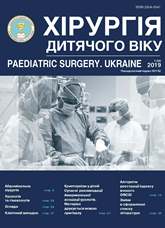Stenting the cutter tension after chemical burn in children: a review of literature and own experience
DOI:
https://doi.org/10.15574/PS.2019.64.28Keywords:
children, burns of the esophagus, treatment, biodegradable, self-expanding stent, esophageal stentingAbstract
For citation: Averin VI, Rustamov VM. (2019). Stenting the cutter tension after chemical burn in children: a review of literature and own experience. Paediatric surgery.Ukraine. 3(64): 28-36. doi 10.15574/PS.2019.64.28Article received: Mar 20, 2019. Accepted for publication: Sep 01, 2019.
Chemical burns of the esophagus is one of the most common types of injuries of the esophagus throughout the world, especially in developing countries, in the age group 3–6 years. It is known that accidental ingestion of even one gulp of a concentrated corrosive substance in the long-term period can lead to severe cicatricial damage to the esophagus, and the primary disability rate for the above reason in people under 18 years of age varies by about 0.5 per 10 thousand people.
Objective: to analyze the review of foreign literature in recent years on chemical burns of the esophagus in children. When considering treatment, most attention is paid to esophageal stenting. To evaluate the effectiveness of the method of stenting of the esophagus with biodegradable stents in the early and distant periods of application of these stents in our clinic.
Materials and methods. In our clinic, there were 13 patients (10 boys and 3 girls) with scar post-burn strictures of the esophagus, who were implanted with 16 ELLA-CS biodegradable stents (one child three times, one time). The most frequently (61.5%) biodegradable stent was installed in children in the age range of 3–5 years, much less frequently (15.4%) – 6-8 years. The average age of patients at the time of stent implantation was 5.5 years.
Results. Analysis of the data showed that in all children in the immediate period of application of the stenting method 1 month), a good result was obtained, namely: the condition of the patients was satisfactory, vomiting, dysphagia and pain were absent. In X-ray monitoring, moderate narrowing of the esophagus was determined in one patient (6.3%) due to stent migration. Perforation of the esophagus and its attendant consequences was not observed a single patient, even with repeated stenting. Thus, the effectiveness of the stenting method in the early period of use 1 month) was 87.5%.
Conclusion. The method of stenting of the esophagus allows you to restore the patency of the esophagus in the stricture zone and to maintain the effective lumen of the esophagus through the use of esophageal, biodegradable, self-expanding stent.
The research was carried out in accordance with the principles of the Helsinki Declaration. The study protocol was approved by the Local Ethics Committee of institution. The informed consent of the patient was obtained for conducting the studies.
Conflict of Interest: No conflict of interest was declared by the authors.
References
Arnold M, Numanoglu A. (2017). Caustic ingestion in children. Semin. Pediatr. Surg.26(2): 95-104. https://doi.org/10.1053/j.sempedsurg.2017.02.002; PMid:28550877
Bychkova OV, Lazyuk II, Averin VI. (2009). Bio-degradable stents – a new approach to the treatment of caustic stenosis in children. Folia Gastroenterol. Hepatol. 7(1): 30-34. http://www.t.pro-folia.org/files/1/2009/1/Bychkova.pdf.
Dall’Oglio L, Caldaro T, Foschia F, Faraci S. et al. (2016). Endoscopic management of esophageal stenosis in children: New and traditional treatments. World J Gastrointest. Endosc. 8(4): 212-9. https://doi.org/10.4253/wjge.v8.i4.212; PMid:26962403 PMCid:PMC4766254.
De Lusong MAA, Timbol ABG, Tuazon DJS. (2017). Management of esophageal caustic injury. World J Gastrointest. Pharmacol. Ther. 8(2): 90-98. https://doi.org/10.4292/wjgpt.v8.i2.90; PMid:28533917 PMCid:PMC5421115.
El-Asmar KM, Hassan MA, Abdelkader HM, Hamza AF. (2015). Topical mitomycin C can effectively alleviate dysphagia in children with long-segment caustic esophageal strictures. Dis Esophagus. 28(5): 422-427. https://doi.org/10.1111/dote.12218; PMid:24708423.
Ham YH, Kim GH. (2014). Plastic and biodegradable stents for complex and refractory benign esophageal strictures. Clin. Endosc. 47(4): 295-300. https://doi.org/10.5946/ce.2014.47.4.295; PMid:25133114 PMCid:PMC4130882.
Hindy P, Hong J, Lam-Tsai Y, Gress F. (2012). A comprehensive review of esophageal stents. Gastroenterol. Hepatol. 8(8): 526-534. https://www.ncbi.nlm.nih.gov/pmc/articles/PMC3533211/pdf/GH-08-526.pdf.
Madadi-Sanjani O, Zimmer J, Gosemann JH, Ure BM et al. (2018, Dec). Topical Mitomycin C application in pediatric patients with recurrent esophageal strictures-report on unfavorable results. Eur J Pediatr Surg. 28(6): 539-546. https://doi.org/10.1055/s-0037-1615278; PMid:29270948.
Millar AJ, Cox SG. (2015). Caustic injury of the oesophagus. Pediatr. Surg. Int. 31(2): 111-21. https://doi.org/10.1007/s00383-014-3642-3; PMid:25432099.
Shub MD. (2015). Therapy of caustic ingestion: new treatment considerations. Curr. Opin. Pediatr.27(5): 609-613. https://doi.org/10.1097/MOP.0000000000000257; PMid:26196260.
Vandenplas Y, Hauser B, Devreker T, Urbain D, Reynaert H. (2017). Endoscopic treatment of benign esophageal strictures with removable or biodegradable stents. In: H Till, M Thomson, J Foker, G Holcomb III, K Khan (Eds.). Esophageal and Gastric Disorders in Infancy and Childhood. Berlin, Heidelberg: Springer: 1119–1125. https://doi.org/10.1007/978-3-642-11202-7_97.
Vandenplas Y. (2017). Management of benign esophageal strictures in children. Pediatr Gastroenterol. Hepatol. Nutr. 20(4): 211-215. https://doi.org/10.5223/pghn.2017.20.4.211; PMid:29302501 PMCid:PMC5750374.
Vieira MC, Bittencourt PFS. (2017). Caustic ingestions. In: H Till, M Thomson, J Foker, G Holcomb III, K Khan (Eds.). Esophageal and Gastric Disorders in Infancy and Childhood. Berlin, Heidelberg: Springer: 701-711. https://doi.org/10.1007/978-3-642-11202-7_59; PMid:28244593 PMCid:PMC5382593.
Downloads
Issue
Section
License
The policy of the Journal “PAEDIATRIC SURGERY. UKRAINE” is compatible with the vast majority of funders' of open access and self-archiving policies. The journal provides immediate open access route being convinced that everyone – not only scientists - can benefit from research results, and publishes articles exclusively under open access distribution, with a Creative Commons Attribution-Noncommercial 4.0 international license(СС BY-NC).
Authors transfer the copyright to the Journal “PAEDIATRIC SURGERY.UKRAINE” when the manuscript is accepted for publication. Authors declare that this manuscript has not been published nor is under simultaneous consideration for publication elsewhere. After publication, the articles become freely available on-line to the public.
Readers have the right to use, distribute, and reproduce articles in any medium, provided the articles and the journal are properly cited.
The use of published materials for commercial purposes is strongly prohibited.

